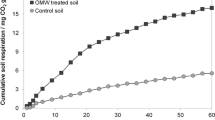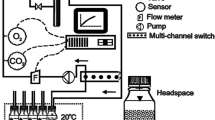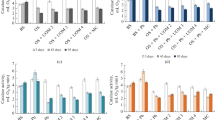Abstract
Phenol, cresols, dimethylphenols and resorcinols are considered major pollutants in the oil-shale semi-coke dump leachates (up to 380 mg phenols/L) that contaminate the surrounding soils and pose a threat to the groundwater in the North-East of Estonia. However, despite high residual concentrations of polyaromatic hydrocarbons (PAHs) and oil products in these soils, the concentration of phenols (especially their water-extractable fraction) was low, not exceeding 0.7 mg/kg dwt. The aim of the current study was to evaluate the role of biodegradation and aging on the decrease of hazard caused by phenolic pollution. The extractability of phenols (phenol, cresols, dimethylphenols and resorcinols) and their biodegradability by the microbial population was studied in the 13 soils sampled from the Estonian oil-shale region, territories of former gas stations, and from presumably non-polluted areas. Phenol, 5-methylresorcinol, p-cresol and resorcinol could be considered easily degradable in the soils as the microbial populations from majority of the soils studied were able to grow on mineral medium supplemented with these phenols as a single source of carbon. 2,3- and 2,4- and 3,4-dimethylphenols could be considered less easily biodegradable.
The semi-coke dump leachate polluted soil (containing no dibasic phenols, 43 mg of monobasic phenols, 1348 mg of oil products and 35 mg of PAHs per g dwt) was analyzed chemically (HPLC) and toxicologically (Flash-Assay usingVibrio fischeri) for the leaching of phenols during shaking of soil-water slurries for 24 h. Only 5.8% of the total concentration of phenols was water-extractable, whereas about 50% of the leached amount was biodegraded by the soil microorganisms. Phenol and cresols were biodegraded by 80%, but the concentration of dimethyl-phenols practically did not change. The pollutants (measured as total water-extractable toxicity) were desorbed from the soil particles by the 8th h of extraction, whereas the toxicity of the aqueous phase continued to increase, probably due to the formation of toxic metabolites. The concentration of water-extractable phenols was too low to explain the toxicity of the extract. Also the impact of PAHs and oil products was excluded. Thus, the relatively low concentration of phenols in the oil-shale region soils is most probably the reflection of both natural attenuation and pollution aging. Therefore, the impact of phenolic compounds to the net bioavailable hazard is probably not so remarkable as it has been considered. The actual pollutants causing the toxicity of the soils from the oil-shale region, however, need to be elucidated.
Similar content being viewed by others
References
Alexander M (2000): Aging, bioavailability, and overestimation of risk from environmental pollutants. Env Sci Technol34, 4259–4265
Aprill W, Sims RC, Sims JL, Matthews JE (1990): Assessing detoxification and degradation of wood preserving and petroleum wastes in contaminated soil. Waste Management and Research8, 45–65
Bispo A, Jourdain MJ, Jauzein M (1999): Toxicity and genotoxicity of industrial soils polluted by polycyclic aromatic hydrocarbons (PAHs). Organic Geochemistry30, 947–952
Boyd EM, Killham K, Meharg AA (2001): Toxicity of mono-, di- and tri-chlorophenols tolux marked terrestrial bacteria,Burkholderia species Rasc c2 andPseudomonas fluorescens. Chemosphere43, 157–166
Boyd TJ, Carlucci AF (1993): Degradation rates of substituted phenols by natural populations of marine bacteria. Aquatic Toxicology25, 71–82
Brenner A, Chozick R, Irvine RL (1992): Treatment of a high-strength mixed phenolic waste in an SRB. Water Environment Research64, 128–131
Broholm M, Arvin E (2000): Biodegradation of phenols in a sandstone aquifer under aerobic conditions and mixed nitrate and iron reducing conditions. Journal of Contaminant Hydrology44, 239–273
Gersberg RM, Carroquino MJ, Fischer DE, Dawsey J (1995): Biomonitoring of toxicity reduction duringin situ bioremediation of monoaromatic compounds in groundwater. Water Research29, 545–550
Kahru A, Kurvet M, Külm I (1996): Toxicity of phenolic wastewater to luminescent bacteriaPhotobacterium phosphoreum. Water Science and Technology33, 139–146
Kahru A, Reiman R, Rätsep A (1998): The efficiency of different phenol-degrading bacteria and activated sludges in detoxification of phenolic leachates. Chemosphere37, 301–318
Kahru A, Põllumaa L, Reiman R, Rätsep A (1999): Predicting the toxicity of oil-shale industry wastewater by its phenolic composition. ATLA27, 359–366
Kahru A, Põllumaa L, Reiman R, Liiders M, Maloverjan A (2000a): The toxicity and biodegradability of eight main phenolic compounds characteristic to the oil-shale industry wastewaters: a test battery approach. Environmental Toxicology15, 431–442
Kahru A, Põllumaa L, Reiman R, Rätsep A (2000b): Microbiotests for the evaluation of the pollution from the oil-shale industry. In: Persoone G, Janssen C, De Coen W (Eds): New Microbiotests for Routine Toxicity Testing and Biomonitoring. Kluwer Academic/ Plenum Publishers, p 357–365
Lappalainen J, Juvonen R, Vaajasaari K, Karp M (1999): A new flash method for measuring the toxicity of solid and colored samples. Chemosphere38, 1069–1083
Licha T, Herfort M, Sauter M (2001): Do phenol plumes exist? In: Seiler KP, Sohlich S (Eds): New Approaches Characterizing Groundwater Flow. Proc. Of the XXXI International Association of Hydrogeologists Congress. Munich. Balkema 2001
McGrath R, Singleton I (2000): Pentachlorophenol transformation in soil: a toxicological assessment. Soil Biology & Biochemistry32, 1311–1314
Mueller JG, Middaugh DP, Lantz SE, Chapman PJ (1991): Biodegradation of creosote and pentachlorophenol in contaminated groundwater: chemical and biological assessment. Applied and Environmental Microbiology57, 1277–1285
Nam K, Alexander M (2001): Relationship between biodegradation rate and percentage of a compound that becomes sequestered in soil. Soil Biology & Biochemistry33, 787–792
Nelson DW, Sommers LE (1996): Total carbon, organic carbon and organic matter. In: Sparks DL et al. (eds): Methods of soil analysis. Part 3. Chemical methods. Soil Science Society of America, Madison WI, p 961–1010
Orupõld K, Masirin A, Tenno T (2001): Estimation of biodegradation parameters of phenolic compounds on activated sludge by respirometry. Chemosphere44, 1273–1280
Orupòld K, Ohlsson A, Henrysson T (1997): Batch trials to simulate biological treatment in lagoons of leachate from oil-shale ash heaps. Oil Shale14 SPECIAL, 476–487
Orupõld K, Tenno T, Henrysson T (2000): Biological lagooning of phenols-containing oil shale ash heaps leachate. Water Research34, 4389–4396
Pôllumaa L, Kahru A, Eisenträger A, Reiman R, Maloveryan A, Rätsep A (2000): Toxicological investigation of soil with the solid-phase flash assay: comparison with other ecotoxicological tests. ATLA28, 461–472
Põllumaa L, Maloveryan A, Trapido M, Sillak H, Kahru A (2001): Study of the environmental hazard caused by the oil-shale industry solid waste. ATLA29, 259–267
Rozkov A, Vassiljeva I, Kurvet M, Kahru A, Preis S, Kharchenko A, Krichevskaja M, Liiv M, Käärd A, Vilu R (1999): Laboratory study of bioremediation of rocket fuel-polluted groundwater. Water Research33, 1303–1313
Sambrook J, Fritsch EF, Maniatis T (1989): Molecular cloning. A laboratory manual. Cold Spring Harbour Laboratory Press, New York
Sooba E, Tenno T, Jauregui O, Galceran MT (1997): Determination of phenols by liquid chromatography with electrochemical and UV detection. Oil Shale14 SPECIAL, 544–553
Svenson A, Zhang L (1995): Acute aquatic toxicity of protolyzing substances studied as the Microtox effect. Ecotoxicology and Environmental Safety30, 283–288
Trapido M (1999): Polycyclic aromatic hydrocarbons in Estonian soil: contamination and profiles. Environmental Pollution105, 67–74
Vanhala PT, Ahtiainen JH (1994): Soil respiration, ATP content, andPhotobacterium toxicity test as indicators of metal pollution in soil. Environmental Toxicology and Water Quality9, 115–121
Wahle U, Kördel W (1997): Development of analytical methods for the assessment of ecotoxicological relevant soil contamination. Part A — development and improvement of soil extraction methods for the determination of the bioavailable parts of contaminants. Chemosphere35, 223–237
Welp G, Brümmer GW (1998): Microbial toxicity of Cd and Hg in different soils related to total and water-soluble contents. Ecotoxicology and Environmental Safety38, 200–204
Wiggins BA, Alexander M (1988): Role of chemical concentration and second carbon sources in acclimation of microbial communities for biodegradation. Applied and Environmental Microbiology54, 2803–2807
Author information
Authors and Affiliations
Corresponding author
Rights and permissions
About this article
Cite this article
Kahru, A., Maloverjan, A., Sillak, H. et al. The toxicity and fate of phenolic pollutants in the contaminated soils associated with the oil-shale industry. Environ Sci & Pollut Res 9 (Suppl 1), 27–33 (2002). https://doi.org/10.1007/BF02987422
Received:
Accepted:
Issue Date:
DOI: https://doi.org/10.1007/BF02987422




